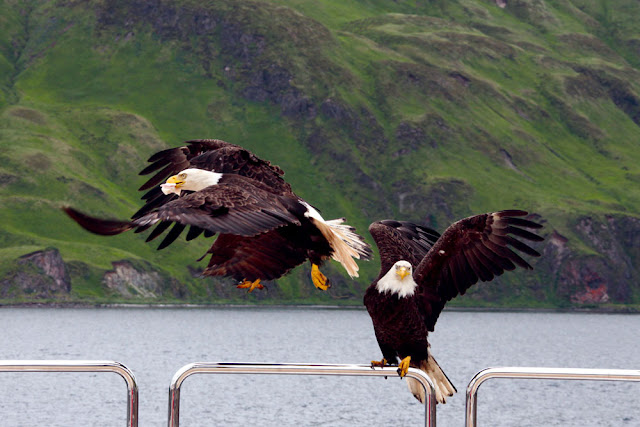The magnificent bald eagle is the
national bird of America, but most Americans are lucky to see one first-hand
during their lifetimes. The Unalaska town offers classic examples of the
striking nature you'll find throughout Alaska, but seems otherwise unremarkable.
Then there's the unnatural amount of eagles here is due to Unalaska simply
being a great place for the birds to score food. Unalaska is located on
Unalaska Island and neighboring Amaknak Island in the Aleutian Islands off
mainland Alaska. The small town of Unalaska, bald eagles are as common as
pigeons are in other human settlements. The Unalaska is home of about 5,000
inhabitants, normally spare the space for bald eagles, who lurk above telephone
poles, and stop lights watching for potential victims to sweep down upon,
litter through trash, and steal grocery bags.
The view looks like out of a
fairytale. Bald Eagles naturally built their nest up in trees, but Unalaska
doesn’t have too many trees. So, Bald eagles find the other way to build their
nests on cliffs, on the edge of town, and in manmade structures. The seven-foot
wingspans, flesh-ripping beaks and vice-like talons, eagles rule the island.
But why are there annual eagle attacks in Unalaska when raptors and humans
peacefully coexist elsewhere in the state?
Therefore, it’s so easy to get a
closer look of an eagle nest without even knowing it. The bald eagles get
attacked anytime, which is why local law enforcement puts up warning signs all
over the nesting season. The nesting season for America’s national bird runs
from early June to the end of the summer. When going near their nests, they may
be get angry and dislike it. So, local people constantly have a keep an eye out
of the birds. There are almost ten cases every year, when people required
medical attention after encounters with eagles with lacerated wounds.
Moreover, fish is the favorite
food of bald eagles, so during fishing season myriad eagles comes to scavenge
and nest in the fishing town, creating lot of irritation to locals. When fresh fish isn’t available, the birds
will anything with meat, seagulls, ducks, squirrels, mice, the occasional
raven, and human leftovers. Despite of all aspects, Unalaska is an excellent
place to watch where you can take marvelous photographs. The bald eagles are
called Dutch Harbor pigeons by locals. The bald eagles swarm every boat that
comes into port, festooning the rigging by the dozen like baleful New Year
ornaments.
Source: Charismatic Planet

























































